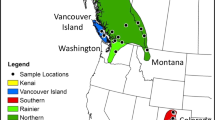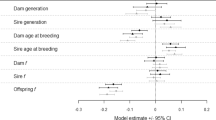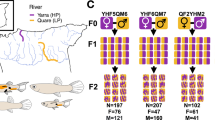Abstract
Microevolution is expected to be commonplace, yet there are few thoroughly documented cases of microevolution in wild populations1,2. In contrast, it is often observed that apparently heritable traits under strong and consistent directional selection fail to show the expected evolutionary response3,4. One explanation proposed for this paradox is that a genetic response to selection may be masked by opposing changes in the environment5,6. We used data from a 20-year study of collared flycatchers (Ficedula albicollis) to explore selection on, and evolution of, a heritable trait: relative body weight at fledging (‘condition’). Despite consistent positive directional selection, on both the phenotypic and the additive genetic component (breeding values, estimated from an animal model) of condition, the mean phenotypic value of this trait in the population has declined, rather than increased, over time. Here we show that, despite this decline, the mean breeding value for condition has increased over time. The mismatch between response to selection at the levels of genotype and phenotype can be explained by environmental deterioration, concealing underlying evolution. This form of cryptic evolution may be common in natural environments.
This is a preview of subscription content, access via your institution
Access options
Subscribe to this journal
Receive 51 print issues and online access
$199.00 per year
only $3.90 per issue
Buy this article
- Purchase on Springer Link
- Instant access to full article PDF
Prices may be subject to local taxes which are calculated during checkout




Similar content being viewed by others
References
Grant, P. R. & Grant, B. R. Predicting microevolutionary responses to directional selection on heritable variation. Evolution 49, 241–251 (1995).
Reznick, D. N., Shaw, F. H., Rodd, F. H. & Shaw, R. G. Evaluation of the rate of evolution in a natural population of guppies. Science 275, 1934–1937 (1997).
Price, T., Kirkpatrick, M. & Arnold, S. J. Directional selection and the evolution of breeding date in birds. Science 240, 798–799 (1988).
Alatalo, R. V., Gustafsson, L. & Lundberg, A. Phenotypic selection on heritable size traits: environmental variance and genetic response. Am. Nat. 135, 464–471 (1990).
Cooke, F., Taylor, P. D., Frances, C. M. & Rockwell, R. F. Directional selection and clutch size in birds. Am. Nat. 136, 261–267 (1990).
Frank, S. A. & Slatkin, M. Fisher's fundamental theorem of natural selection. Trends Ecol. Evol. 7, 92–95 (1992).
Lynch, M. & Walsh, B. Genetics and Analysis of Quantitative Traits (Sinauer, Sunderland, Massachusetts, 1998).
Roff, D. A. Evolutionary Quantitative Genetics (Chapman & Hall, New York, 1997).
Hochachka, W. & Smith, J. N. Determinants and consequences of nestling condition in song sparrows. J. Anim. Ecol. 60, 995–1008 (1991).
Lindén, M., Gustafsson, L. & Pärt, T. Selection of fledging mass in the collared flycatcher and the great tit. Ecology 73, 336–343 (1992).
Both, C., Visser, M. E. & Verboven, N. Density-dependent recruitment rates in great tits: the importance of being heavier. Proc. R. Soc. Lond. B 266, 465–469 (1999).
Sorci, G. & Clobert, J. Natural selection on hatching body size and mass in two environments in the common lizard (Lacerta vivipara). Evol. Ecol. Res. 1, 303–316 (1999).
Boltnev, A. I., York, A. E. & Antonelis, G. A. Northern fur seal young: interrelationships among birth size, growth, and survival. Can. J. Zool. 76, 843–854 (1998).
Merilä, J. Genetic variation in offspring condition—an experiment. Funct. Ecol. 10, 465–474 (1996).
Merilä, J., Kruuk, L. E. B. & Sheldon, B. C. Natural selection on the genetical component of body condition in a wild bird population. J. Evol. Biol. (submitted).
Conover, D. O. & Schultz, E. T. Phenotypic similarity and the evolutionary significance of countergradient variation. Trends Ecol. Evol. 10, 248–252 (1995).
Visser, M. E. & Holleman, L. J. M. Warmer springs disrupt the synchrony of oak and winter moth phenology. Proc. R. Soc. Lond. B 268, 289–294 (2001).
Gustafsson, L. Inter- and intraspecific competition for nest holes in a population of the collared flycatcher Ficedula albicollis. Ibis 130, 11–16 (1988).
Doligez, B., Danchin, E., Clobert, J. & Gustafsson, L. The use of conspecific reproductive success for breeding habitat selection in a non-colonial, hole-nesting species, the collared flycatcher. J. Anim. Ecol. 68, 1193–1206 (2000).
Alatalo, R. V. & Lundberg, A. Density-dependence in breeding success of the pied flycatcher (Ficedula hypoleuca). J. Anim. Ecol. 53, 969–978 (1984).
Lewontin, R. C. Adaptation. Sci. Am. 239, 212–230 (1978).
Gilchrist, A. S. & Partridge, L. A comparison of the genetic basis of wing size divergence in three parallel body size clines of Drosophila melanogaster. Genetics 153, 1775–1787 (1999).
Sheldon, B. C., Merilä, J., Lindgren, G. & Ellegren, H. Gender and environmental sensitivity in nestling collared flycatchers. Ecology 79, 1939–1948 (1998).
Groeneveld, E. REML VCE, a Multivariate Multi-Model Restricted Maximum Likelihood (Co)Variance Component Estimation Package, Version 3.2 User's Guide. (Institute of Animal Husbandry and Animal Behaviour, Federal Research Center of Agriculture (FAL), Mariensee, Germany, 1995). 〈http://www.tzv.fal.de/institut/genetik/pub/eg/vce/manual/manual.html〉
Groeneveld, E., Kovac, M., Wang, T. L. & Fernando, R. L. Computing algorithms in a general purpose BLUP package for multivariate prediction and estimation. Arch. Anim. Breed. 15, 399–412 (1992).
Meyer, K. Restricted maximum-likelihood to estimate variance components for animal models with several random effects using a derivative-free algorithm. Genet. Selection Evol. 21, 317–340 (1989).
Blair, H. T. & Pollak, E. J. Estimation of genetic trend in a selected population with and without the use of a control population. J. Anim. Sci. 58, 878–886 (1984).
Southwood, O. I. & Kennedy, B. W. Genetic and environmental trends for litter size in swine. J. Anim. Sci. 69, 3177–3182 (1991).
Merilä, J., Sheldon, B. C. & Ellegren, H. Antagonistic natural selection revealed by molecular sex identification of nestling collared flycatchers. Mol. Ecol. 6, 1167–1175 (1997).
Genstat, 1998. Genstat 5, Release 4.1 (Lawes Agricultural Trust, IACR, Rothamsted, 1998).
Acknowledgements
We thank I. P. F. Owens, A. J. van Noordwijk, B. Walsh and D. A. Roff for comments on the manuscript, M. Visser for data on caterpillars and oaks, and the numerous people who have helped in collecting the data in the course of the study, in particular L. Gustafsson. Our research was supported by the Swedish Natural Science Research Council, the Nordic Academy for the Advanced Study (J.M.) and by Royal Society University Research Fellowships to B.C.S. and L.E.B.K.
Author information
Authors and Affiliations
Corresponding author
Rights and permissions
About this article
Cite this article
Merilä, J., Kruuk, L. & Sheldon, B. Cryptic evolution in a wild bird population. Nature 412, 76–79 (2001). https://doi.org/10.1038/35083580
Received:
Accepted:
Issue Date:
DOI: https://doi.org/10.1038/35083580
This article is cited by
-
Expanding the application of haplotype-based genomic predictions to the wild: A case of antibody response against Teladorsagia circumcincta in Soay sheep
BMC Genomics (2023)
-
Reversed evolution of grazer resistance to cyanobacteria
Nature Communications (2021)
-
Evolutionary quantitative genetics of juvenile body size in a population of feral horses reveals sexually antagonistic selection
Evolutionary Ecology (2019)
-
Will human influences on evolutionary dynamics in the wild pervade the Anthropocene?
BMC Biology (2018)
-
Genetic Associations Between Personality Traits and Lifetime Reproductive Success in Humans
Behavior Genetics (2016)
Comments
By submitting a comment you agree to abide by our Terms and Community Guidelines. If you find something abusive or that does not comply with our terms or guidelines please flag it as inappropriate.



